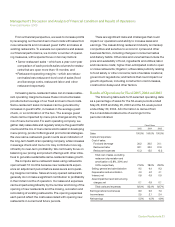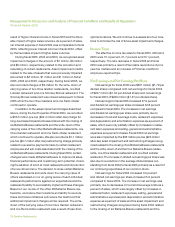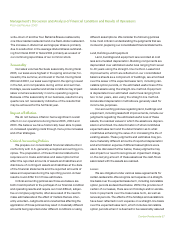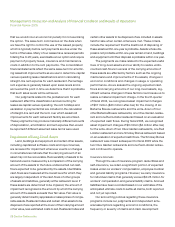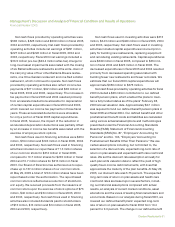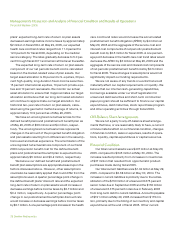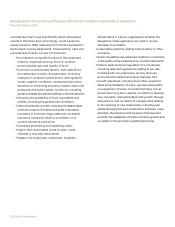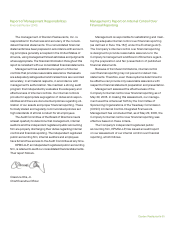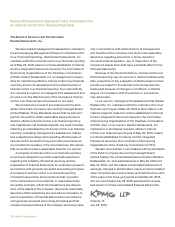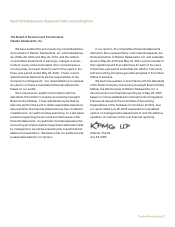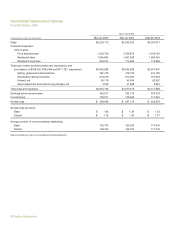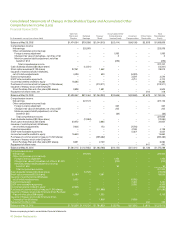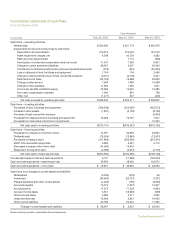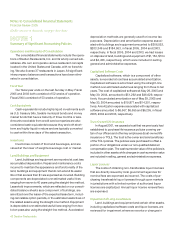Red Lobster 2005 Annual Report Download - page 25
Download and view the complete annual report
Please find page 25 of the 2005 Red Lobster annual report below. You can navigate through the pages in the report by either clicking on the pages listed below, or by using the keyword search tool below to find specific information within the annual report.Management’s Discussion and Analysis of Financial Condition and Results of Operations
Financial Review 2005
Darden Restaurants 33
liabilities of $254 million at May 29, 2005 increased from
$228 million at May 30, 2004, primarily due to a $20 million
increase in liabilities associated with our non-qualified
deferred compensation plan.
Quantitative and Qualitative Disclosures
About Market Risk
We are exposed to a variety of market risks, including
fluctuations in interest rates, foreign currency exchange
rates, compensation and commodity prices. To manage
this exposure, we periodically enter into interest rate, for-
eign currency exchange, equity forwards and commodity
instruments for other than trading purposes (see Notes 1
and 9 of the Notes to Consolidated Financial Statements).
We use the variance/covariance method to measure
value at risk, over time horizons ranging from one week to
one year, at the 95 percent confidence level. At May 29,
2005, our potential losses in future net earnings resulting
from changes in foreign currency exchange rate instru-
ments, commodity instruments and floating rate debt
interest rate exposures were approximately $6 million
over a period of one year (including the impact of the
interest rate swap agreements discussed in Note 9 of
the Notes to Consolidated Financial Statements). The
value at risk from an increase in the fair value of all of our
long-term fixed rate debt, over a period of one year, was
approximately $17 million. The fair value of our long-term
fixed rate debt during fiscal 2005 averaged $668 million,
with a high of $677 million and a low of $655 million. Our
interest rate risk management objective is to limit the
impact of interest rate changes on earnings and cash
flows by targeting an appropriate mix of variable and
fixed rate debt.
Future Application of Accounting Standards
In December 2004, the FASB issued SFAS No. 123
(Revised), “Share-Based Payment.” SFAS No. 123R
revises SFAS No. 123, “Accounting for Stock-Based
Compensation,” and generally requires the cost associ-
ated with employee services received in exchange for
an award of equity instruments be measured based on
the grant-date fair value of the award and recognized in
the financial statements over the period during which
employees are required to provide service in exchange
for the award. SFAS No. 123R also provides guidance
on how to determine the grant-date fair value for awards
of equity instruments as well as alternative methods of
adopting its requirements. SFAS No. 123R is effective for
annual reporting periods beginning after June 15, 2005.
As disclosed in Note 1 of the Notes to Consolidated
Financial Statements, based on the current assumptions
and calculations used, had we recognized compensa-
tion expense based on the fair value of awards of equity
instruments, net earnings would have been reduced by
approximately $18 million, $15 million and $17 million
for fiscal 2005, 2004 and 2003, respectively. We have
not yet determined the method of adoption or the effect
of adopting SFAS No. 123R and have not determined
whether the adoption will result in future amounts similar
to the current pro forma disclosures under SFAS No. 123.
Forward-Looking Statements
Certain statements included in this report and other
materials filed or to be filed by us with the SEC (as well as
information included in oral or written statements made
or to be made by us) may contain statements that are for-
ward-looking within the meaning of the Private Securities
Litigation Reform Act of 1995, as codified in Section 27A
of the Securities Act of 1933, as amended, and Section
21E of the Securities Exchange Act of 1934, as amended
(the Exchange Act). Words or phrases such as “believe,”
“plan,” “will,” “expect,” “intend,” “estimate,” and “proj-
ect,” and similar expressions are intended to identify
forward-looking statements. All of these statements, and
any other statements in this report that are not historical
facts, are forward-looking. Examples of forward-looking
statements include, but are not limited to, projections
regarding: our growth plans and the number and type of
expected new restaurant openings and related capital
expenditures; same-restaurant sales growth; expected
diluted net earnings per share growth; expected trends
that might impact capital requirements and liquidity;
expected contributions to our defined benefit pension
plans; and the impact of litigation on our financial posi-
tion. These forward-looking statements are based on
assumptions concerning important factors, risks and


